Before we bid 2020 a final farewell, we share some of our favorite writing from the past year. We wish all of you a happy and healthy New Year, with the hope for brighter days in 2021.
In the end, there was darkness; a great yawning maw that filled the heavens with nothing but an almost unbroken tapestry of emptiness. Alone, sitting upon a rock that resists that nothing, is All-Father Thor. After his battle with Cosmic Doom, after returning from doing his part in the War of the Realms, he rests among his people, with his granddaughters alongside him, keenly aware that the end is nigh. Yet, as he has done time and time again, he musters the courage to believe that it is not the end. Not quite. There is still a spark left in his old all-bones.
There is still thunder in his veins.
Welcome back, one and all, to the column fit to hold the hammer. Welcome to the column that follows the moniker of Thor. Welcome back. . .to Worthy.
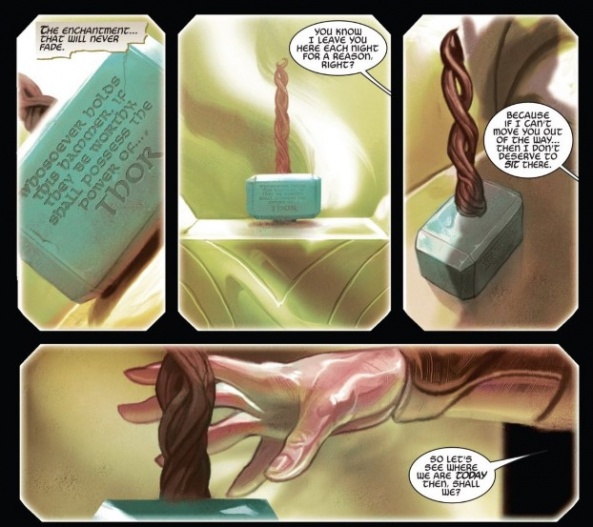
This is it. The end of Jason Aaron’s run on Thor. Seven, creeping into eight years with the God of Thunder, crafting an Epic for the ages. This is the way Thor ends. This is the way Thor ends. Not with a bang, but with a Krakakoom.
For now, for those of you who need a (not so quick) refresher of the events up until now, Part 1, Part 2, Part 3 and, Part 4 of Worthy are ready to be (re)read.
Spoilers ahead. But I suspect you already knew that.
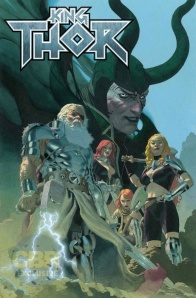
“King Thor” Year 7-8
At the End of Time, a Battle, a Resolution, and Once More, We Return to This
Kevin recently had me on his podcast, Make Mine Multiversity to talk about, among other things, three (mini)series that recently wrapped up: “Gwenpool Strikes Again,” “Guardians of the Galaxy,” and “King Thor.” All three operate as series that are following up on, and acting as the conclusions to, work done elsewhere: “Guardians” is closing up Cates’ cosmic stuff, “Gwenpool” is closing up, well, Gwenpool and her place in the Marvel U at large, and “King Thor” closes up Aaron’s take on the Thor mythos, as well as the events seeded throughout his run.
If you want to hear my mostly rambling thoughts on the other books, please give it a listen; Kevin works hard on these and deserves our love. I bring this up not just to plug the pod but also because Kevin posed a question which I think is worth asking and considering: Why was this series necessary?
If you’ve followed this column, you may have an answer ready made, and I do too, but questions are best when grappled with instead of dismissed. So. . .why was this necessary? What do we gain from another four issues of Thor? If we were to chop off the final panel and page of “Thor” (2018), that would have served as a worthy (heh) send-off for the God of Thunder. The War of the Realms was complete, Thor was about to begin the long journey to becoming King Thor and feeling more comfortable in his new role, and we had gotten the state of affairs for the realm such that Cates can easily slot in as the new writer.
Kevin is right in that, much like Return of the King, there is ending after ending and it feels like we’re dragging our feet, not wanting to leave a party that was over hours ago, which, in one sense, is true. Aaron states in his farewell letter that he found it difficult to let Thor go. He had all these ideas he never got to explore, all these places he wanted to take the God of Thunder, and he kept wanting to have one last adventure with Thor before handing him over to another.

Art by Esad Ribić. Colors by Ive Svorcina. Letters by Joe Sabino.
And so, that’s what “King Thor” is; it is the epilogue to the epilogue. It is the fulfillment of this saga as an Epic in the style of Gilgamesh or Beowulf or Conan. A sword and sorcery tale for the ages, something intimate and emotional, with big drama and big consequences. A last adventure for the God of Thunder and a celebration of who he was and what he means.
The echoes of a particularly large thunderclap.
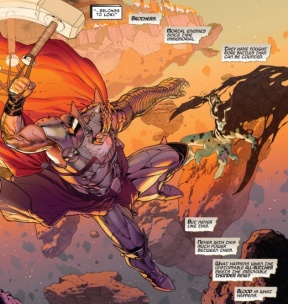
Art by Ribić. Colors by Svorcina. Letters by Sabino.
While it is true that this adventure can be considered superfluous to what had come before, and in fact may be superfluous in reiterating Aaron’s themes, it does not overstay its welcome and, by the end, the story feels more open than ever, a difficult enough feat to do for any regular series, let alone an adventure as wide as this one.
It becomes clear at the end of issue #4 that “King Thor” was a necessary capstone for Aaron’s Thor. It provides new insights into King Thor and his melancholy, follows up on the Loki threads from “Thor” (2018,) and offers one last look at worthiness and the less than clean nature of it all. To do this, “King Thor” takes us all the way back to the beginning, to a story about two brothers, one with murder in his heart, fighting.
King Thor has seen nothing but grief since we met him, from his own battles with Gorr and then Galactus: Butcher of Worlds, to the death and rebirth of Midgard. From the death of the new Jane to fighting the Herald Supreme Doom and now, fighting his brother, once more: All-Father vs All-Butcher. This is the end Loki saw way back in Laufey’s gullet, the one teased at least as far back as “The Mighty Thor” #700, and “Civil War II.”
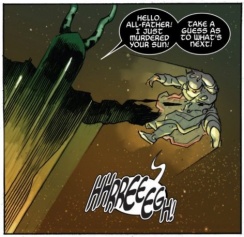
Art by Ribić. Colors by Svorcina.
Letters by Sabino.
It is a battle for the ages, one that pulls no punches but is focused far more on the words than the actions. In fact, the physical swings are almost irrelevant to their battle and, when taken out of the frame of the story, seem almost comical. Planets are thrown about like baseballs, necro-ravens attack Atli, Elli, and Frigg, Thor lights his hammer on fire so a planet of napalm can be blown up on Loki. It’s all so big and bombastic and silly, but the tone is so deeply earnest, and the writing so sharp and emotional, the silliness melts away, leaving a story you can’t help but take seriously — the anti-Gurren Lagan.
But there is only so much battling with Loki that can be done before it becomes tired and old hat, which is why Aaron takes us all the way back to the beginning, why Ribić and Svorcina have returned, and why Sabino gets to break out a font we haven’t seen in a long while.
Gorr the God Butcher lives and he is back to rid the universe of its final two gods.
The reveal of his return is a page of majesty, reminding us why Ribić and Svorcina were first chosen to bring the Saga of the God-Butcher to life. Painted with soft but deep colors and dark, speckled blacks, the portrait conveys power in an ancient way, as if we were looking upon a tapestry of some long forgotten king.
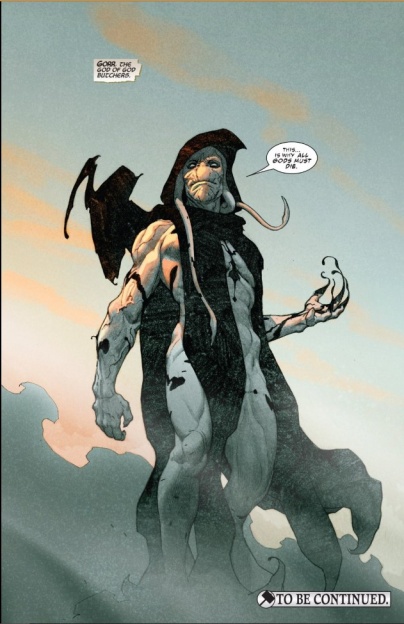
This grand scope and ancient, timeless feel continues throughout the comic and, if I may be so bold, this is the team’s finest work yet. Every panel is a masterfully crafted painting, ranging from the cosmic might of a planet being cleaved in twain to the somber, quiet of a woman praying at the foot of a trussed-up Loki, both silhouetted against the setting sun that’s just peeking over the mountains. For that alone, to see this book is worth the price of admission.
As for Gorr, while the reason for his return is a bit contrived — Loki revives him from being inside the necro-sword — it feels right and the explanation holds weight, with the why of it providing another wrinkle in the tale of the Odinson brothers.
Continued belowAt first, we are meant to believe that Loki was afraid all those years of being good, all the kindness and faith his brother showed him, would have him hesitate at the end. This is a perfectly valid reason, one borne out by the text and the events of Present Loki. . .but we are not with him now. We are at the end of the universe with Loki the Necro-God and he is far less concerned with being good or worthy than his younger counterpart.
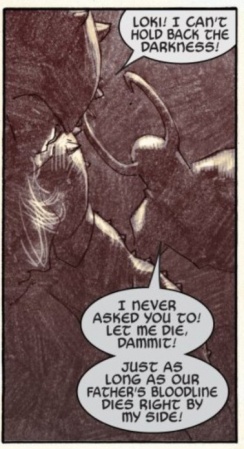
Colors by Svorcina. Letters by Sabino.
He was more afraid that, after all was said and done, that he could not end his own life. Why, though? What does he gain from death? There are a few ways to read it but here’s my take: Loki has always been jealous of Thor and wanted to destroy Thor, to best him. That was his ultimate goal, nothing more. Once that is achieved, there is nothing left in the universe for him to do and, it is at that moment that he must live with the awful things he has done, with the love of his mother reminding him of what could have been if he had put down the hatred.
What is left for the God of Lies and Stories if there is no one to tell them to but himself?
Therefore, he brought back Gorr to do what he could not: take him out. There is a reading where he did this out of a subconscious desire to atone, if we take his “and we are far too old and deserving of his rage” statement in isolation. But I see this as an admission of his own struggle with the front he put up, of the lessons of his youth catching up to him and reminding him that his story does not have to end with him as the bad guy, even if he believes that to be one final lie he tells himself.
Before we get back to Loki’s ultimate fate, and Aaron’s final word on his worthiness, let’s shift gears to the other storyline going on in this mini: that of Thor’s granddaughters. They are searching for a way to save the universe and stop Loki and end up at omnipotence city, home of the God of Librarians and the Halls of All-Knowing, and home to the God made Pariah by Gorr — Shadrak, God of Bombs. I’ve always loved Shadrak, he was a character that was best used sparingly, so seeing him again at the end as the once more crazed god who has forgotten who he once was, knowing he should be dead but somehow has survived, was nostalgic and tragic all over again.
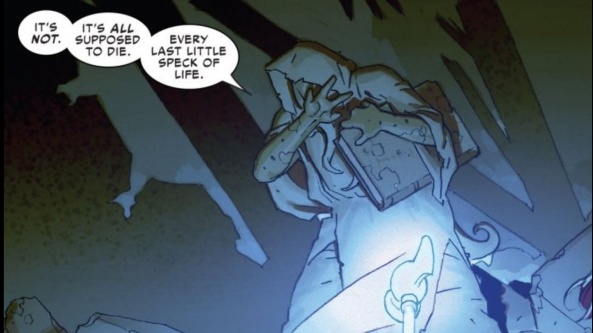
However, Aaron presents this not as a tragedy but as the natural progression of things. Decay at the end of the universe is the natural state, nothing more, nothing less but that doesn’t mean we can’t fight against it, rage against the dying of the light, to build an outpost in the darkness and try to create something new from the ashes of the old. Shadrak sends the Wodendottirs off to do just that, book in hand, with the knowledge that, when you’re trying to find an ending, you must first return to the beginning.
If that isn’t a statement of intent for Shadrak’s whole journey, and for “King Thor,” I don’t know what is.
Where, then, do the Wodendottirs go? Well, back to a planet which was once desert. A planet where, once, a girl prayed to gods long butchered, a prayer answered by a penitent Thor, who brought new gods to the planet. They go there to learn what their grandfather learned so long ago: one cannot think themselves above prayer or action, for on that road lies Gorr and the Gods who long abandoned him. We must be willing to do both, to humble oneself while using one’s power to assist those who do not have it.
.push({});
</script></div><hr/>Art and Colors by Das Pastoras. Letters by Sabino.)
Atli, Frigg and Elli’s short stay on Indigarr is illustrated by Das Pastoras, who we have not seen since “Thor: God of Thunder” #18, and is another fantastic example of how the artists on this book are chosen to both hearken back to prior adventures and create a visual distinction between stories or locations that require it. Ribić and Svorcina could have done these pages but then the story would not have had the same impact or the same resonance.
The lessons the Wodendottirs learn on Indigarr are not the same as the ones told elsewhere. It is a story of young gods learning the power of their actions, just as Young Thor learned the price of recklessness, but as with all good tales of the future, this time around the lesson is learned before the toll is exacted. When the children learn from the mistakes of their parents, and take to heart the successes, then the world, the universe, has a fighting chance.
This reminder of what Gorr’s actions wrought, that he became that which he always resented, a god, while facilitating the revival of a godless world, highlights both his and Thor’s mindsets. . .and why he will ultimately lose. Because he comes from a place of hate, a place of distrust, and a failure to understand, he may be right in his philosophy but he is wrong in his actions — he did not learn the correct lessons.

Art by Ribić. Colors by Svorcina. Letters by Sabino.
The gods were unworthy because they were convinced they were right, always, that theirs was a mandate from heaven and immutable and that the power they wielded was for them, not for those they served. We saw this with the gods of the Shi’ar during the ‘Asgard/Shi’ar War’ arc, and again in ‘The Testament of Jane Foster’ during the ‘The Death of the Mighty Thor’ arc.
So too is Gorr convinced, wholly and completely, that he is righteous and correct in his actions. That the gods must die because they cannot learn and it is only through their utter annihilation that all peoples can be free, never questioning if what he is doing is causing more harm than good, if he is becoming the very despots he sought to destroy.
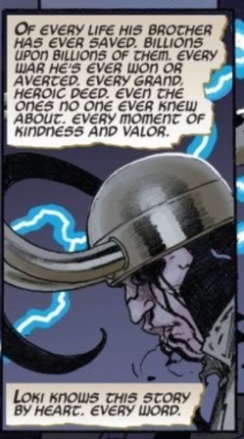
Art by Ribić. Colors by Svorcina.
Letters by Sabino.
Thor, on the other hand, is a god who once was the very thing Gorr accused him of: a vain, selfish and uncaring ruler. He flitted down to earth to satisfy his own pleasures, of wine and war, answering prayers as it fit him, never considering the people who asked the prayers. This characterization is not monolithic, as Aaron charts throughout the many Young Thor interludes, but it isn’t until he encounters Gorr that it begins to change in earnest. The great irony of Gorr is that he succeeded, just not in the way he thought he would.
His actions were the driving force behind Thor’s self-doubt and rediscovery, of becoming the god worthy of wielding Mjolnir and the one to begin the great project of reviving the universe. He inspired Thor to become the inspiration for the other gods. It was only through Gorr’s tempering that Thor could find it in himself to continually remember the good in Loki and to hold out hope that maybe one day he could finally get through to his brother. It was only through Gorr’s questioning of Thor’s worldview that he could recognize the hypocrisies within and the problems his father perpetuated and failed to address.
It is through Gorr that Thor learns that questioning and struggling with power are the only ways to be worthy of that power.
And so, just as Aaron’s take on Thor began with Gorr and his disappointment-turned-hatred of gods, so too does it ends with him on the verge of, once again, completing his mission. He is ready to annihilate the universe and, were it not for a few choice words from Loki, and the final acceptance of the thunder and doubt into Thor, he would have succeeded.
Continued belowGorr is defeated by the thunder, yes, but more so with the confrontation of the fact that, while he was right, Thor was not a god but instead was something greater. Thor is Thor, something different, someone who struggles every day, for eons upon eons, to be worthy, who hopes to one day be rid of his doubts but knows, deep down, that without those doubts and demons, he could never achieve the good that he does.
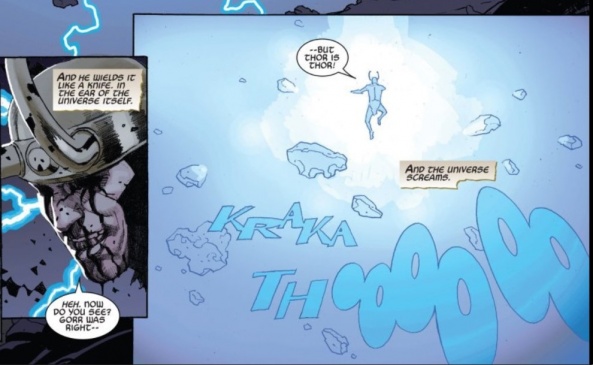
This is why Aaron makes it a point, at the end, to show King Thor in the midst of another existential crisis. For all the positives and reconciliations at the end of “Thor” (2018,) it is important to be reminded that things do not always wrap up in a nice, neat bow. Odin’s centuries of poor parenting and lack of love left an indelible mark on Thor that haunts him even now, at the end of time.
He cries out for Odin’s love, echoing all the horrible insults that were thrown at him over the centuries, that he was never worthy of the name and so was in no position to give it up, that he wasn’t strong enough to withstand the thunder, crying at its sound, that he was never cruel enough or aloof enough to be a god. Odin was wrong on all three counts but the mark was left.
What gets King Thor to be the hero, to defeat Gorr, is his own reconciliation of that which he learned at the end of “War of the Realms,” that worthiness is a process, with his secret hope to one day be free of his doubts. He knows now, right at the end, that it is an impossibility to be fully free of ones demons and doubts. . .and that is OK. It is possible to be good and kind and to affect the world in the best of ways while retaining doubt and pain and worry. That it is possible to fail and hurt others and still make amends, so long as it comes from a place of sincerity.
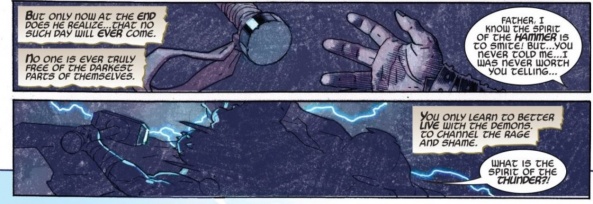
We see this in Thor’s conversations with Loki at the end of Issue #2, when in the dark ocean of Gorr. The lie from issue #1, about Freyja cursing Loki with her dying breath, is washed away with the truth that even in death, she hoped and believed that Loki would find his way back to where he once thought he could be, to be good in spite of all the bad. To do the right thing, for the right reasons, at the right time, in order for the work to not be tainted.
To be worthy.
This comment is the turning point for him, making its way into Loki’s cold, nearly dead heart. Just when he thought his story was written, with him as the villain, an immutable, immovable end, the opportunity to reach out for his brother’s hand in peace and pledge himself to saving the universe instead of destroying it presents itself.
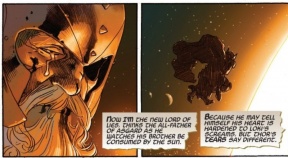
Colors by Svorcina. Letters by Sabino.
Thor has always believed in his brother, in spite of all the harm he has caused, and while his granddaughters may not share that sentiment, they give Loki the chance to prove them wrong, handing him the book that we have been hearing from since the beginning, writing the final chapter of the God-Butcher and, ultimately sacrificing himself to save the sun and Midgard, an eternal prison where Loki, finally, was allowed to become the God of Stories. It is also fitting that Toothgnasher, the goat he revived at the end of “Thor” (2018) is the one who accompanies him into the sun.
Just as Cul was given an end both emotionally arresting and not absolving, so too is Loki given the same here. His desires are not fulfilled, his past actions not washed away and pasted over, but he goes out providing the spark that will let others live. It is the ending he deserves, to be trapped, of his own volition, in a sun over a world that he has tried over and over and over and over and over again to destroy in order to save it, not with lies but, instead, with stories.
Continued belowIn one final bit of poetry to cap off the series, Thor too finds himself at the center of a dying cosmic entity, battling back the darkness with the thing that is central to himself. Just as Loki feeds the sun with his stories, Thor feeds the universe with his thunder, on a page that is beautiful and meaningful, sparse and yet full, a contradiction that is full of life.
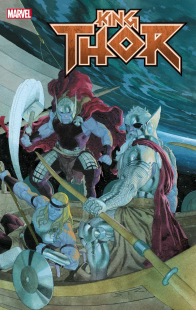
Stories and Endings in a Genre that Never Ends
Before we send the Saga of King Thor off, I wanted to briefly touch on the one aspect of “King Thor” that fits as a piece of the greater whole rather than as a piece of the mini-series it finds itself in. I’m referring, of course, to the mid-section of issue #4, where we jump back in time to visit Shadrak, still crashing at the Halls of All-Knowing and reading the stories of Thor. He is berated by the Librarian for letting the books fall to the ground before commenting on how, often, Thor was more trouble than he was worth.
We are then treated to a sampling platter of artists and ideas that jump from age to age, teasing Thor adventures we will probably never see and plot points that hint at ideas unexplored, such as Atli, Frigg, and Elli’s parents and grandmother, or Thor God Cop. It’s a fun set of stories that, thanks to the frame, feel necessary to read about, even if they are superfluous to King Thor’s final battle. Just as we began this article asking why does this exist, the same question can be applied to this section: Why is it here?
Well, three reasons. It’s a statement on the nature of stories and our unending desire to have more of the ones that connect with us, one last hoorah for Aaron to explore aspects of Thor he could not before as well as give just one more glimpse into present day and a commentary on endings. This desire to have more stories, however, is antithetical to our desire for endings; it’s a tension that Aaron knows well.
We never want something we love to be gone, or to finish, but we know that if it keeps on, forever and ever, it will wither and become a husk of what it once was.
This is why the most difficult part of any superhero comic is creating an ending that is satisfying, definitive and yet allows for the story to continue without cheapening the resolutions provided. By its very nature as a corporate owned genre, for the most part, the machine cannot abide a popular character sitting with a singular ending. Every ending is but the beginning for another story and this is good for those who wish for greater adventures but not for those who wish to have an end.
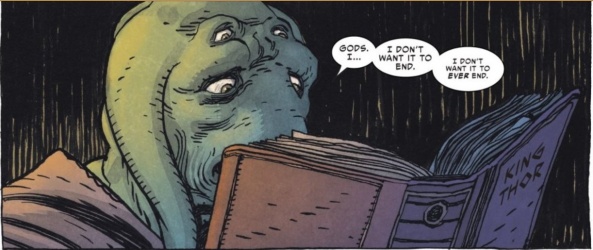
Art by Gabriel Hernandez Walta. Colors by Chris O'Halloran. Letters by Sabino.
This is true of Thor as much as it is any other and yet, Aaron has managed to do the unthinkable and create an ending that hits all three beats with aplomb. It is a testament to his control of tone and story as well as to the pure magic of this creative team. Not a single panel, color, word, or sound is out of place, everything is leveraged to have maximum impact and leave anyone who has read for the past seven years, or even just the last four months, feeling satisfied.
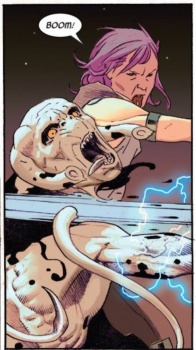
use this panel. Art by Ribić.
Colors by Svorcina. Letters by Sabino.
The inclusion of the extra stories, and the Shadrak frame, therefore, primes us to see the final scene of “King Thor” as the last word, as a definitive but open ending, by changing our perception. This was not a character’s journey, with a beginning, middle, and end, where everything is chronicled. Instead, it is just one of the many stories told about Thor, one with many holes that are left open for others to fill in, just as he did for the origins of All-Black the Necrosword. It is also here to get us comfortable with the idea that there is no direct line from the young All-Father Thor to the old King Thor, that whatever comes next must be held on its own, just as these vignettes are.
Continued belowThey connect by virtue of being the same character but remain vastly different; there is no one singular tale that can capture the full picture and so we shouldn’t expect it to. Moreover, we must understand that these stories exist now and that existence cannot be negated by what is told next nor does it negate what came before.
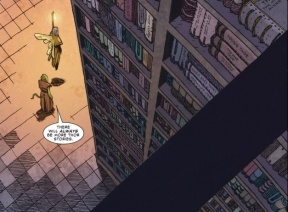
Art by Walta. Colors by O'Halloran.
Letters by Sabino.
If the Saga of the God Butcher is not to your liking, then maybe Thor God Cop will be more your speed. If The Death of the Mighty Thor is too sad, maybe Thor Corp is the story for you. Maybe none are, maybe all are. Regardless, the stories remain and each are there to be heard, to be read, to be experienced.
But that doesn’t mean we can’t take one last look back at the characters we left behind, needing that last little bit of knowledge of what came before to properly say goodbye. Aaron gives us that with one last bit of Coipel/Martin, Dauterman/Wilson, and Del Mundo art. Baldr and the norns have returned with his assuming Karnilla’s old post just as she took up him. Sif has taken over for Heimdall after his demise in the pages of “Jane Foster: Valkyrie,” a series that was just outside the scope of this column, mainly because of time.
Finally, we check in on how Jane is taking to being Valkyrie, and on how Thor is taking to being All-Father of a newly rebuilt Asgard, both reflecting the growth they have undergone these last five years. A fitting send off for the former goddess and current god of thunder but not the final ones of the series.
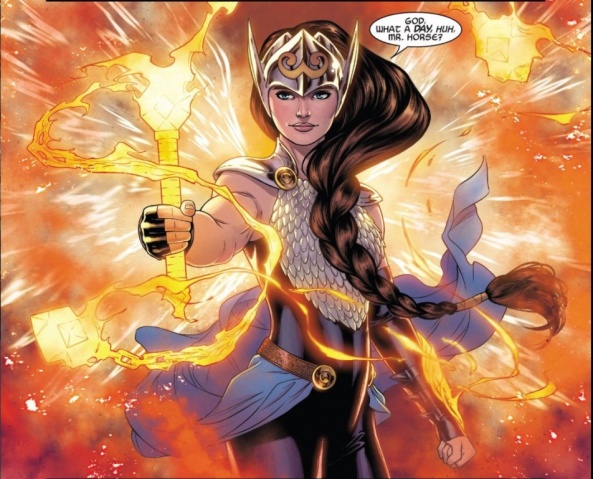
Art by Russell Dauterman. Colors by Matthew Wilson. Letters by Sabino.
“King Thor” closes on scenes from the end of the universe, checking in on the three principal characters of this final chapter and on the three who will continue the legacy onwards. Atli, Frigg, and Elli send the past off to its end, and, through this, we are assured that there remain future stories to be told, even though this one is rapidly nearing its conclusion.
As for that past, Gorr is living a life he was denied for so long, Loki’s stories are doing far more good than his lies ever did, and Thor, Thor is saying his goodbyes. He is Aaron and he is us, dreading the task ahead but knowing it must be done for this Epic to have any satisfaction. He rubs his hands in earth one final time, just as we take one final pass at the stories of this Thor, and then sets off into the darkness, fighting back the vacuum of nothingness, with only the sound of thunder to let us know he is still there.
There is nothing left for him to do or say, and so Aaron leaves us with one final story, one from Thor’s childhood, juxtaposed against King Thor’s final actions, reminding us of the power of stories. . .and thunder.
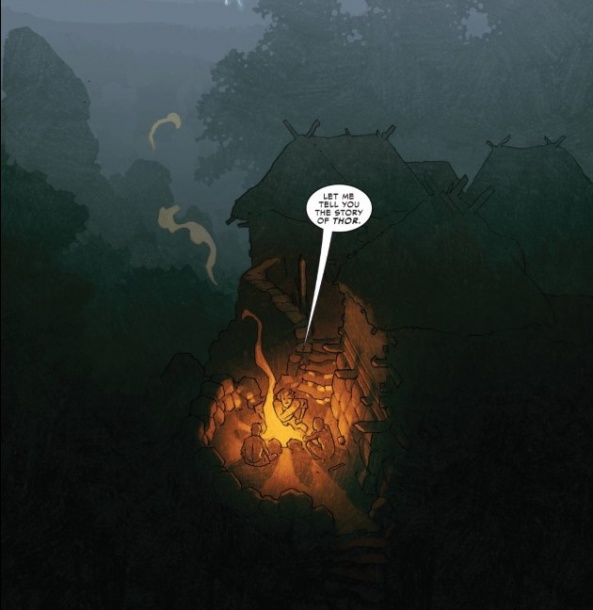
Farewell
With that, we have reached the finale of Jason Aaron’s seven year Thor saga and the finale of Worthy. It’s been a two year journey for me here, one that began with a “simple” retrospective. Thank you to all of you who’ve read each one of these. I know I didn’t make it easy on you but I hope this gave you a better appreciation for a run that, for my money, will live on far beyond its original publication.
I want to give a thank you to Jason Aaron, for producing such a saga, and to Joe Sabino for lettering every issue to perfection. This man deserves recognition and letterers sadly do not get enough of it. Thank you to the teams of Esad Ribić & Ive Svorcina, Russell Dauterman & Matthew Wilson, and Mike Del Mundo & Marco D’Alfonso for bringing your all to the main titles and defining an era. You six were the backbone of this run and without you, it would never have turned out as amazing as it did.
Continued belowAnd a hearty thank you all the other artists (pencilers, inkers, colorists, plus a co-writer once) who have contributed over the years. Let’s see if I can get them all, in no particular order, though grouped by team with no repetitions.
*deep breath* Thank you Dean White, Oliver Coipel, Laura Martin, Ron Garney, Das Pastoras, Chris Sprouse, Karl Story, Goran Sudžuka, Dexter Vines, Marte Gracia, Israel Silva, RM Guera, Giulia Brusco, Simon Bisley, Nic Klein, Butch Guice, Tom Palmer, Kim Jacinto, Pascal Alixe, Mat Lopes, Jay David Ramos, Al Ewing, Simone Bianchi, Szymon Kudranski, Marco Checchetto, Riccardo Pieruccini, Adriano Dall’alpi, Nolan Woodard, Paul Mounts, Jen Bartel, Ramón Pérez, Rafa Garres, Frazer Irving, Steve Epting, Frank Martin, Valerio Schiti, Veronica Gandini, Rain Beredo, Walter Simonson, Daniel Acuña, James Harren, Becky Cloonan, Chris Burnham, Andrew MacLean, Jill Thompson, Dave Stewart, Christian Ward, Tony Moore, John Rauch, Lee Garbett, Antonio Fabela, Scott Hepburn, Gabriel Hernandez Walta, Chris O’Halloran, Andrea Sorrentino, Nathan Fairbairn, and Aaron Kuder.
Farewell, one and all. May we meet again in the future, where stories of the thunder are told far and wide, where we know what the spirit of thunder is, and where we remember just what it means. . .to be worthy.
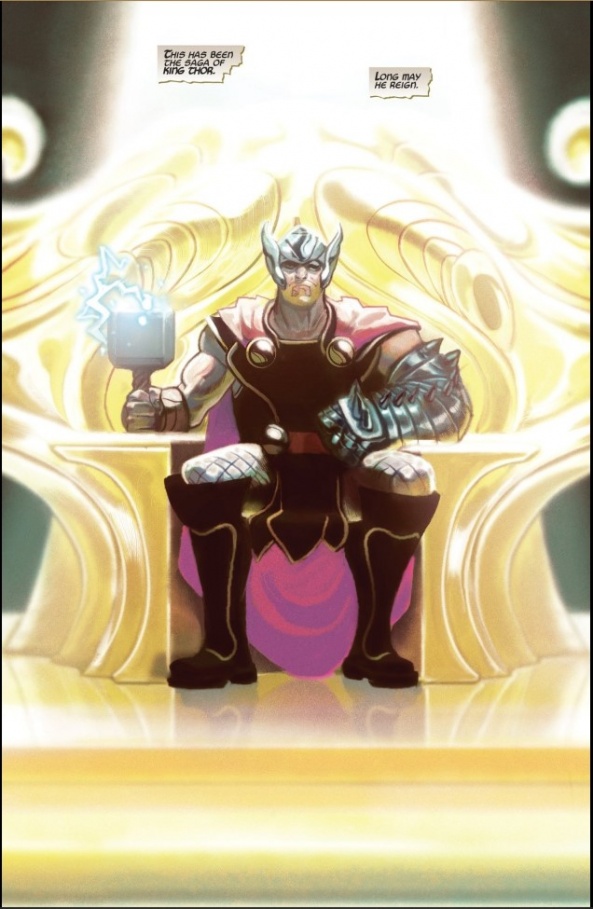
Part 1: ‘Worthy’
Part 2: ‘The Death of the Mighty Thor.’
Part 3: ‘Thor in Hel and Other Stories.’
Part 4: ‘War of the Realms’






